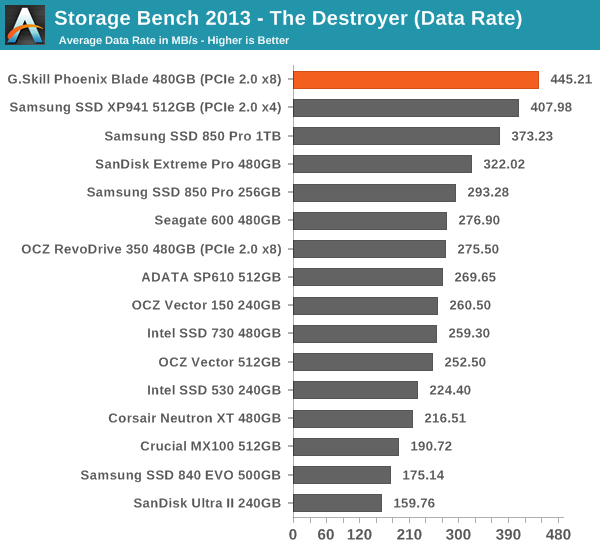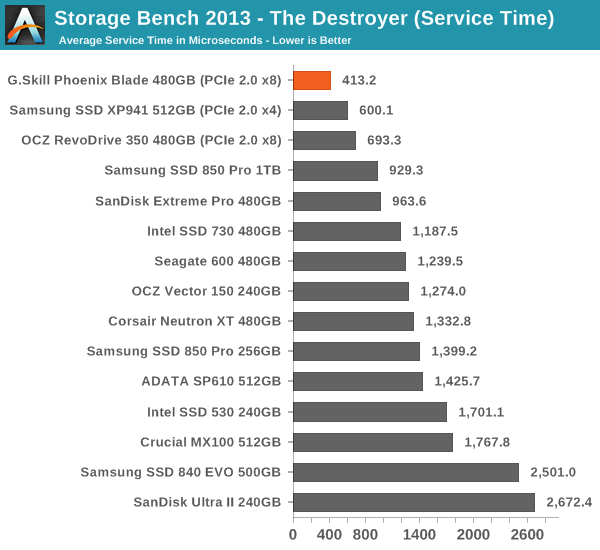G.Skill Phoenix Blade (480GB) PCIe SSD Review
by Kristian Vättö on December 12, 2014 9:02 AM ESTAnandTech Storage Bench 2013
Our Storage Bench 2013 focuses on worst-case multitasking and IO consistency. Similar to our earlier Storage Benches, the test is still application trace based – we record all IO requests made to a test system and play them back on the drive we are testing and run statistical analysis on the drive's responses. There are 49.8 million IO operations in total with 1583.0GB of reads and 875.6GB of writes. I'm not including the full description of the test for better readability, so make sure to read our Storage Bench 2013 introduction for the full details.
| AnandTech Storage Bench 2013 - The Destroyer | ||
| Workload | Description | Applications Used |
| Photo Sync/Editing | Import images, edit, export | Adobe Photoshop CS6, Adobe Lightroom 4, Dropbox |
| Gaming | Download/install games, play games | Steam, Deus Ex, Skyrim, Starcraft 2, BioShock Infinite |
| Virtualization | Run/manage VM, use general apps inside VM | VirtualBox |
| General Productivity | Browse the web, manage local email, copy files, encrypt/decrypt files, backup system, download content, virus/malware scan | Chrome, IE10, Outlook, Windows 8, AxCrypt, uTorrent, AdAware |
| Video Playback | Copy and watch movies | Windows 8 |
| Application Development | Compile projects, check out code, download code samples | Visual Studio 2012 |
We are reporting two primary metrics with the Destroyer: average data rate in MB/s and average service time in microseconds. The former gives you an idea of the throughput of the drive during the time that it was running the test workload. This can be a very good indication of overall performance. What average data rate doesn't do a good job of is taking into account response time of very bursty (read: high queue depth) IO. By reporting average service time we heavily weigh latency for queued IOs. You'll note that this is a metric we have been reporting in our enterprise benchmarks for a while now. With the client tests maturing, the time was right for a little convergence.

Quite surprisingly, the Phoenix Blade takes the lead in our 2013 Storage Bench and even beats the XP941. After reviewing the RevoDrive 350, I didn't get my hopes up for the Phoenix Blade, but it looks like G.Skill has done a much better job at optimizing the drive for performance.











62 Comments
View All Comments
Duncan Macdonald - Friday, December 12, 2014 - link
How does this compare to 4 240GB Sandforce SSDs in software RAID 0 using the Intel chipset SATA interfaces?Kristian Vättö - Friday, December 12, 2014 - link
Intel chipset RAID tends not to scale that well with more than two drives. I have to admit that I haven't tested four drives (or any RAID 0 in a while) to fully determine the performance gains, but it's safe to say that the Phoenix Blade is better than any Intel RAID solution since it's more optimized (specific hardware and custom firmware).nathanddrews - Friday, December 12, 2014 - link
Sounds like you just set yourself up for a Capsule Review.Havor - Saturday, December 13, 2014 - link
I dont get the high praise of this drive, sure it has value for people that need high sequential speed, or people that use it to host a database on a budget that have tons of request, and can utilize high QD, all other are better off with a SATA SSD that preforms much better with a QD of 2 or less.As desktop users almost never go over QD2 in real word use, so they would be much better of with a 8x0 EVO or so, both performance wise as price wise.
I am actually wane of the few that could use the drive, if i had space for it (running quad SLI), as i use a RAMdrive, and copy programs and games that are stored on the SSD in a RAR file, true a script from a R0 set of SSDs to the RAMdisk, so high sequential speed is king for me.
But i count my self in the 0.1% of nerds, that dose things like that because i like doing stuff like that, any other sane person would just use a SSD to run its programs of.
Integr8d - Sunday, December 14, 2014 - link
The typical self-centered response: "This product doesn't apply to me. So I don't understand why anyone else likes it or why it should be reviewed," followed by, "Not that my system specs have ANYTHING to do with this, but here they are... 16 video cards, raid-0 with 16 ssd's, 64TB ram, blah blah blah..." They literally just look for an excuse to brag...It's like someone typing a response to a review of Crest toothpaste. "I don't really know anything about that toothpaste. But I saw some, the other day, when I went to the store in my 2014 Dodge Charger quad-Hemi supercharged with Borla exhaust, 20" BBS with racing slicks, HID headlights, custom sound system, swimming pool in the trunk and with wings on the side so I can fly around.
It's comical.
dennphill - Monday, December 15, 2014 - link
Thanks, Integ8d, you put a smile on my face this morning! My feelings exactly.pandemonium - Tuesday, December 16, 2014 - link
Hah. Nicely done, Integr8d.alacard - Friday, December 12, 2014 - link
The DMI interface between the chipset and the processor maxes out at about 1800~1850MB/s and this bandwidth has to be split between all the devices connected to the PCH which also incorporates an 8x pci 2.0 link. Simply put, there's not enough bandwidth to go around with more than two drives attached to the chipset in raid, not to mention that the scaling beyond 2 drives is fairly bad in general through the PCH even when nothing else is going on. And to top it all off 4k performance is usually slightly slower in Raid than a on a single SSD (ie it doesn't scale at all).I know Tomshardware had an article or two on this subject if you want to google it.
personne - Friday, December 12, 2014 - link
It takes three SSDs to saturate DMI. And 4k writes are nearly double on long queue depths. So you get more capacity, higher cost, and much of the performance benefit for many operations. Certainly tons more than a single SSD at a linear cost. If you research your statements.alacard - Friday, December 12, 2014 - link
To your first point about saturating DMI, we're in agreement. Reread what i said.To your second point about 4k, you are correct but i've personally had three separate sets of RAID 0 on my performance machine (2 vertex 3s, 2 vertex 4s, 2 vectors), and i can tell you that those higher 4k results were not impactful in any way when compared to a single SSD. (Programs didn't load faster for instance.)
http://www.tomshardware.com/reviews/ssd-raid-bench...
That leaves me curious as to what you're doing that allows you to get the benefits of high queue depth RAID0? What's your setup, what programs do you run? I ask because for me it turned out not to be worth the bother, and this is coming from someone who badly wanted it to be. In the end the higher low queue depth 4k of 1 SSD was a better option for me so i switched back.
http://www.hardwaresecrets.com/article/Some-though...